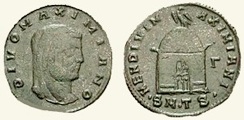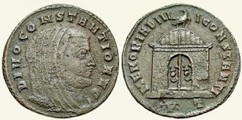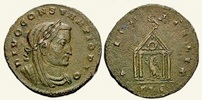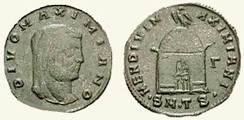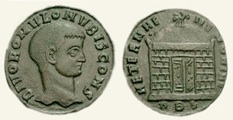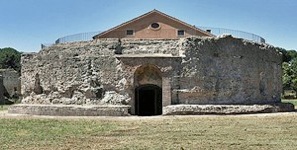Maxentius for DIVO CONSTANTIO AVG/ Maxentius for DIVO ROMVLO N V BIS CONS/
MEMORIA DIVI CONSTANTI AETERNAE MEMORIAE
RIC VI Ticinum 97 (ca. 307 AD) RIC VI Rome 207 (ca. 309 AD)
Licinius for DIVO MAXIMIANO (Galerius)/ MEM DIVI MAXIMIANI
RIC VI Thessalonica 48 (ca. 311 AD)
A number of the coins discussed in the page on Consecrated Tetrarchs employed a reverse design that depicted a domed, mausoleum-like structure with an eagle (symbolising apotheosis) perched above:
-
✴RIC Ticinum 97 (illustrated above), which Maxentius minted for divus Constantius in 307-8 AD;
-
✴eight coins that Maxentius minted for divus Romulus in ca. 309-11 AD:
-
•RIC Rome: 207, illustrated above; 226; 239; 240 and 257); and
-
•RIC Ostia; 34; 58 and 59; and
-
✴RIC Thessalonica 48 (illustrated above), which Licinius minted for divus Galerius in ca. 311 AD.
The doors of the structures on the coins for divus Constantius and divus Galerius were closed, while those on the coins for divus Romuls were ajar.
It is reasonable to consider whether these designs represented (or at least symbolised) specific buildings, perhaps the mausolea of the respective subjects. Some scholars have made the suggestion in individual cases:
-
✴Küthmann and Overbeck (referenced below) identified:
-
•the reverse design of RIC Ostia 34 for divus Romulus as “the tomb of Romulus, son of Maxentius” (in his entry 42, p 26-7); and
-
•the reverse design of t RIC Ticinum 97 for divus Constantius as “the tomb of Constantius I Chlorus at Trier” (in his entry 43, p 27).
-
(These are my translations of the titles given to these respective entries).
-
✴David Sear (in his entry 15046, RIC Rome 207 for divus Romulus) asserted that this coin :
-
“....doubtless represents the sepulchre of divus Romulus, which was erected on the Appian Way.”
-
This observation also applied by implication to all the coins all the other coins for divus Romulus listed above (i.e. his entries 15049-54, which he labelled as similar to it).
-
✴Thomas Bayet (referenced below, at p 76) mused that:
-
“We are tempted to compare [the reverse design of the coin above from] Thessalonica with the Rotunda of St George [there], ... which is known to have been [intended for use as] the mausoleum of Galerius. However, the resemblance is unfortunately not particularly striking.” (my translation).
This possibility is considered below for each of the structures in turn, before a general conclusion is offered.
‘Mausoleum’ Coin for Divus Constantius (?)
Maxentius for DIVO CONSTANTIO AVG/ MEMORIA DIVI CONSTANTI
RIC VI Ticinum 97 (ca. 307 AD)
What is known about the burial of Constantius is discussed in my page page on the Accession of Constantine (306 AD). Mark Johnson (referenced below, 1992), who had scoured the scant evidence for the burial location of Constantius, reluctantly concluded that:
-
“Beyond the fact that he was honourably buried and [consecrated], nothing is certain. It would seem most likely that he was buried near one of his residences, perhaps York but, more probably, near his principal residence at Trier”.
In the associated note 11, he observed that:
-
“There is... no hard evidence for [the putative mausoleum of divus Constantius at Trier] cited by Küthmann and Overbeck [as above]”.
It is hard to imagine that Constantius was not buried in a mausoleum, like his colleagues in the first Tetrarchy:
-
✴In two cases, the mausoleum in question was associated with a planned retirement palace:
-
•Diocletian built his mausoleum within his retirement palace at Spalato (Split, in modern Croatia); and
-
•Galerius built his on a sacred site about 1 km from, and connected by road to, his retirement palace at Romuliana (modern Gamzigrad, in Serbia).
-
✴However, Maximian had built his just outside his capital at Milan (albeit that he had retired to southern Italy). Mark Johnson (referenced below, 2009, ) marked its location in a plan of Milan at this time (Plate 5, at p 7). The extramural mausoleum was about 1 km from the part of the city that housed the imperial place and circus.
It is entirely possible:
-
✴that Maximian had established a similar complex at his earlier capital at Trier in 283-293 AD; or
-
✴that Constantius had followed Maximian’s example at Milan when Trier became his capital in 293-306 AD.
There is important literary evidence for the palace complex and circus at Trier in a panegyric (Panegyric VI, translated into English in Nixon and Rodgers, referenced below) that was delivered at the court of Constantine there in 310 AD, on the anniversary of the foundation of the city. The panegyrist referred to Trier as:
-
“... a prosperous city ... [that is] being rebuilt so splendidly along its entire circuit of walls ... [which has] become greater by your benefactions [Constantine]. I see: a circus maximus to rival ... that in Rome; basilicas and a forum; palatial buildings; and a seat of justice ...”
The scant archeological evidence for these structures can be seen in the plan of Augusta Treverorum in the website Wikiwand, in which;
-
✴the circus is at 6;
-
✴the forum is at 1; and
-
✴the famous Basilica of Constantine, which was probably the panegyrist’s ‘seat of justice’ and would have been at the heart of the palace complex, is at 2.
There is evidence that the circus was actually in use before the reign of Constantine: an inscription (CIL XIII 3672, LSA-2610) from the base of a statue that was found nearby reads:
Indulgentissimo/ d(omino) n(ostro) Flavio Val(erio)/ Constantio/ nobilissimo/ Caes(ari)
Valerius Concordius/ v(ir) p(erfectissimus) dux
devo/tus numini / mai{i}estati/que eorum
To our most clement lord, Flavius Valerius Constantius, most noble Caesar
Valerius Concordius, of perfectissimus rank, dux (military commander)
devoted to their divine spirit and majesty [set this up]
As Christian Witschel pointed out in the notes on the LSA entry, this was one of a collection of statues erected by Valerius Concordius, presumably one of each Tetrarch, since he was devoted to their spirit and majesty. It clearly dates to the period 293-305 AD, when Constantius was Caesar. That suggests that the circus had been built by Constantius himself or by his predecessor, Maximian. It is also more than likely that the nearby palace complex had been constructed in this period, albeit that Constantine might well have restored and enhanced it. The parallel with Maximian’s place complex and circus at Milan suggests that there might well have been an extramural imperial mausoleum nearby, albeit that any trace of it has yet to be found.
It is important to remember that Maxentius minted this coin for divus Constantius to commemorate the alliance with Constantine that his father, Maximian had recently cemented during a visit to Trier. Divus Constantius now reflected glory and legitimacy on the whole Herculean dynasty (i.e. on Maximian, his son-in-law Constantine, and his son Maxentius). The reverse design was completely new, and it is difficult to imagine that it did not have specific dynastic significance:
-
✴It might have represented, or at least symbolised, the putative extramural mausoleum at Trier discussed above. If this mausoleum had existed, Constantine would surely have interred his father in it, and Maximian would have visited it during his stay there.
-
✴Alternatively (and, in my view, less probably), the design might have represented, or at least symbolised, Maximian’s mausoleum at Milan, where the cult of the Herculean divus Constantius might have been celebrated.
Of course, the evidence for either of these hypotheses is entirely circumstantial. Nevertheless, it is difficult to escape the conclusion that the structure depicted or symbolised a funerary structure of some kind (and most probably a mausoleum) that was a locus of a dynastic cult that perpetuated Constantius’ memory.
Constantine for DIVO CONSTANTIO PIO/ MEMORIA FELIX
RIC VI Lyon 269: Sear 16428
It is true that Constantine did not employ a reverse design of this kind on his consecration coins for his father. However, he adopted a similar approach in the unusual reverses of two MEMORIA FELIX coins (which were both minted at Lyon). These depicted an eagle standing in a temple. David Sear (referenced below) cataloged them as:
-
✴16427 (not catalogued in RIC), in which the temple had only two columns; and
-
✴16428 (RIC VI Lyon 269, illustrated above), which depicted a tetrastyle temple.
It is possible that the temples in these coins, like the putative mausoleum in the coin minted by Maxentius, represented one or more actual cult sites.
‘Mausoleum’ Coin for Divus Galerius (?)
Licinius for DIVO MAXIMIANO (Galerius)/ MEM DIVI MAXIMIANI
RIC VI Thessalonica 48 (ca. 311 AD)
Thomas Bayet rejected his own tentative suggestion (above) regarding the identification of the structure on the coins that Licinius minted for divus Galerius as the Rotunda of St George at Thessalonica, the city in which it was minted. His insight was sound: as pointed out in the page of Consecrated Tetrarchs, this structure is no longer considered to have been designed as a mausoleum. However, there is a more likely candidate: the mausoleum at Romuliana [modern Gamzigrad], where Galerius was (almost certainly) buried. As discussed in this earlier page, it is likely that Licinius had presided over the funerary rites of Galerius, which included his consecration, prior to his burial in the mausoleum.
The discussion in the the page of Consecrated Tetrarchs also pointed out that this was the only conventional consecration coin type that Licinius minted for divus Galerius: his other coins in this category were all hybrids, which employed what were normally ‘lifetime’ reverses. Since Licinius paid so little attention to this aspect of his coinage, it is difficult to believe that he took much trouble over this, his only ‘real’ consecration reverse. It seems more likely (at least to me) that he merely adapted the Maxentian coin above for divus Constantius to serve his purpose, which was probably to commemorate the funerary rites at which he had recently officiated. If that is accepted, then the reverse above almost certainly depicted, or at least symbolised, the mausoleum at Romuliana (with the corollary that the divus Constantius coin must also have depicted or symbolised his mausoleum, wherever it was).
‘Mausoleum’ Coin for Divus Romulus (?)
Maxentius for DIVO ROMVLO N V BIS CONS/ AETERNAE MEMORIAE
RIC VI Rome 207 (ca. 309 AD)
The first series of coins that Maxentius minted for divus Romulus comprised:
-
✴RIC Rome: 207, illustrated above; 226; 239; 240; and 257; and
-
✴RIC Ostia: 34; 58; and 59.
These coins were characterised by:
-
✴the obverse legend DIVO ROMVLO N V BIS CONS (divus Romulus, of most noble rank, twice Consul (note: the obverse legend of RIC Ostia 59 is incorrectly entered in RIC - see the illustration of this coin and associated description in this page in the website Coinproject.com); and
-
✴the unprecedented reverse legend ‘AETERNAE MEMORIAE’.
They all had a reverse design that depicted a domed structure with an eagle above that represented the apotheosis of divus Romulus. The wall that formed either the facade of the domed structure or part of its enclosure was in “opus quadratum” (square-section masonry in parallel layers), uninterrupted by columns.
Maxentius would later include further coins for divus Romulus in a dynastic series that also included coins for the divi Constantius, Maximianus and Galerius. The reverse designs of these coins also depicted domed structures with eagles above. However, in this case, the structures seem to represent either tetrastyle (four-columned) or hexastyle (six-columned) temples. Elisha Ann Dumser (referenced below), who analysed the reverse designs from both series as a single set, concluded (at p 146) that:
-
“... it is highly doubtful that such dramatically diverse architectural types could all refer to the same physical building”.
However, when she restricted her analysis to the “opus quadratum” design (i.e. those that lacked columns), she conceded (at p 144) that:
-
“Shifts [between these designs] are rather minor and fall within the expected range of variability for architectural types.”
In other words, considered alone, these reverse designs could have represented a specific physical building.
Philip Hill (referenced below, at p 13) came to the conclusion that the building represented in this first series of divus Romulus coins was quite distinct from that represented in the later, dynastic series:
-
“In point of fact, two different buildings are shown [in Maxentius’ divus Romulus coins]:
-
-one with a plain brick facade [used for all the DIVO ROMVLO N V BIS CONS coins but no others]; and
-
-the other with four or six columns in the Corinthian order and a lintel above the door.
-
We may therefore conjecture with some reason that the first represents the sepulchre of Romulus on the Appian Way ...”.
This mausoleum is described in my page on Maxentius' Complex on Via Appia). It seems likely that this had been conceived as a dynastic mausoleum, and that Romulus’ early death (probably by accidental drowning in the Tiber) meant that, unexpectedly, he was the first member of the family to be buried in it. (It can be visited, but its dome, if it was ever built, no longer survives).
However, a number of scholars have considered and rejected this proposition. For example, Naja Regina Armstrong (referenced below, at p 240-1) mused:
-
“As [Romulus’] resting place and part of a dynastic complex in honour of Maxentius and his gens, it would be logical ... [to assume] that the mausoleum on the via Appia [was] depicted on Maxentius’ coins. However, difficulties arise in assigning even the first series [of divus Romulus coins] to this mausoleum:
-
✴[These coins do not depict] the building’s projecting porch ...;
-
✴.... more fundamentally, there is no sure parallel for a private mausoleum depicted on a coin; and
-
✴... as Maxentius is not known to have illustrated monuments outside of Rome, a rotunda to which his coins may be attributed must be sought within the city limits”.
However, taking her points in turn:
-
✴The mausoleum on the Via Appia might well have been unfinished at the time of Romulus’ unexpected death and, in particular, its columned pronaus might not have been built. Alternatively, the coins might depict the mausoleum as seen from the Via Appia, with its dome appearing above the wall of its square temenos (sacred enclosure).
-
✴The mausoleum on Via Appia was built next to a circus that could accommodate some 10,000 people , which was surely used (inter alia) for the funerary games of divus Romulus and for subsequent games associated with his cult. In addition, the main entrance to the temenos and to the mausoleum itself faced the (public) Via Appia, and its upper storey was probably also used for the celebration of the cult. In other words, this was hardly a private mausoleum.
-
✴Given the dynastic significance of the mausoleum, there is no obvious reason why its position outside the city limits should have precluded it from representation on Maxentius’ coins.
In short, it seems to me that the mausoleum on Via Appia is an excellent candidate for the structure that was depicted, or at least symbolised, in the reverse designs of the first series of coins that Maxentius minted for divus Romulus.
Conclusions
The reverse design of each of the three coin types considered here was meant to convey:
-
✴the apotheosis of a particular individual subject (divus Constantius, divus Galerius or divus Romulus) by means of an eagle; and
-
✴the perpetuation of his earthly memory.
Traditionally, the latter concept had been conveyed by means of a lit altar that represented the earthly cult. However, changes in funerary practices in late antiquity offered an alternative: as Mark Johnson (referenced below, 2009, at p 188) observed, by this time:
-
“... mausolea were not just repositories for the remains of deceased emperors. These buildings also served as settings for cult practices, both on the private, familial level and on the public level.”
He also suggested (at p 108) that the upper storeys in the two-storey imperial mausolea of the tetrarchic period were specifically intended as the loci of these cult practices. Thus, it would be unsurprising if mausolea were now sometimes used as alternatives to lit altars on consecration coins.
The analysis of this topic has been unnecessarily complicated (in my view) by the fact that the reverse designs of Maxentius’ dynastic series for the divi Constantius, Romulus, Maximianus and Galerius, have too often been included. In fact, their function was quite different: these coins were intended to express Maxentius’ own position within a dynasty that included four deified members, all buried in different places. The domed structures on these reverses most probably represented (however symbolically) one or more sites at which the cult of all four was celebrated (as discussed in the page on Maxentius’ Dynastic Consecration Coins).
Once this complication has been removed, the consideration of the domed structures on the reverses the coins on this page becomes more straightforward, not least because the problem of diverse architectural types is removed. There is now no obvious reason why these could not represent (however symbolically) the respective mausolea. Indeed, it is difficult to envisage an alternative explanation for them.
Read more:
‘RIC’ - see Sutherland (1967) below
M. Johnson, “The Roman Imperial Mausoleum in Late Antiquity”, (2009) Cambridge
E. Dumser, "The Architecture of Maxentius: A Study in Architectural Design and Urban Planning in Early 4th Century Rome" (2005), Dissertation of University of Pennsylvania
N. Armstrong, “Round Temples in Roman Architecture of the Republic through the Late Antique Period”, (2001) Thesis of University of Oxford
C. E. V. Nixon and B. S. Rodgers, “In Praise of Later Roman Emperors: The Panegyrici Latini”, (1994) Berkeley
T. Bayet, “Architectura Numismatica : Iconographie Monétaire du Temple de Rome, des Mausolées et des Ouvrages Fortifiés au Bas-Empire”, Revue Belge de Numismatique, 139 (1993) 59-81
M. Johnson, “Where were Constantius I and Helena Buried?”, Latomus, 51 (1992) 145-50
P. Hill, “The Monuments od Ancient Rome as Coin Types”, (1989) London
H. Küthmann, and B. Overbeck. “Bauten Roms auf Münzen und Medaillen”, (1973) Munich
C. Sutherland, “Roman Imperial Coinage: Volume VI: From Diocletian’s Reform to the Death of Maximinus (294-313 AD)”, (1967, reprinted 1973) London
Galerius as Augustus II (308-11 AD) Licinius (308-11 AD)
Maxentius in Rome: (308-11 AD) Maxentius' Public Works
Maxentius' Complex on Via Appia Maxentius' Coins for Divus Romulus (309 AD)
Constantine in Gaul (308-11 AD) Constantine, Divus Claudius and Sol Invictus
Consecrated Tetrarchs (306-11 AD) Consecrated Tetrarchs: Mausoleum Coins
Literary Sources : Diocletian to Constantine (285-337 AD)
Return to the History Index




